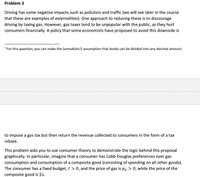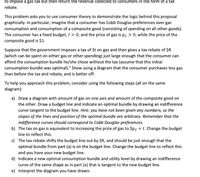
ENGR.ECONOMIC ANALYSIS
14th Edition
ISBN: 9780190931919
Author: NEWNAN
Publisher: Oxford University Press
expand_more
expand_more
format_list_bulleted
Question

Transcribed Image Text:Problem 3
Driving has some negative impacts such as pollution and traffic (we will see later in the course
that these are examples of externalities). One approach to reducing these is to discourage
driving by taxing gas. However, gas taxes tend to be unpopular with the public, as they hurt
consumers financialy. A policy that some economists have proposed to avoid this downside is
' For this question, you can make the (unrealistic!) assumption that books can be divided into any decimal amount.
to impose a gas tax but then return the revenue collected to consumers in the form of a tax
rebate.
This problem asks you to use consumer theory to demonstrate the logic behind this proposal
graphically. In particular, imagine that a consumer has Cobb Douglas preferences over gas
consumption and consumption of a composite good (consisting of spending on all other goods).
The consumer has a fixed budget, I > 0, and the price of gas is pg > 0, while the price of the
composite good is $1.

Transcribed Image Text:to impose a gas tax but then return the revenue collected to consumers in the form of a tax
rebate.
This problem asks you to use consumer theory to demonstrate the logic behind this proposal
graphically. In particular, imagine that a consumer has Cobb Douglas preferences over gas
consumption and consumption of a composite good (consisting of spending on all other goods).
The consumer has a fixed budget, I > 0, and the price of gas is pg > 0, while the price of the
composite good is $1.
Suppose that the government imposes a tax of $t on gas and then gives a tax rebate of $R
(which can be spent on either gas or other spending) just large enough that the consumer can
afford the consumption bundle he/she chose without the tax (assume that this initial
consumption bundle was optimal).? Show using a diagram that the consumer purchases less gas
than before the tax and rebate, and is better off.
To help you approach this problem, consider using the following steps (all on the same
diagram):
a) Draw a diagram with amount of gas on one axis and amount of the composite good on
the other. Draw a budget line and indicate an optimal bundle by drawing an indifference
curve tangent to the budget line. Hint: you have not been given any numbers, so the
slopes of the lines and position of the optimal bundle are arbitrary. Remember that the
indifference curves should correspond to Cobb Douglas preferences.
b) The tax on gas is equivalent to increasing the price of gas to $pg + t. Change the budget
line to reflect this.
c) The tax rebate shifts the budget line out by $R, and should be just enough that the
optimal bundle from part (a) is on the budget line. Change the budget line to reflect this
and you have your new budget line.
d) Indicate a new optimal consumption bundle and utility level by drawing an indifference
curve of the same shape as in part (a) that is tangent to the new budget line.
e) Interpret the diagram you have drawn.
Expert Solution
This question has been solved!
Explore an expertly crafted, step-by-step solution for a thorough understanding of key concepts.
This is a popular solution
Trending nowThis is a popular solution!
Step by stepSolved in 2 steps with 1 images

Knowledge Booster
Similar questions
- For the following problems, choose from these formulas: Formula 1 A = P +Prt Formula 3 A = P(1 + APR)" P = Formula 2 P A 1+rt Formula 4 A APR (ny) n (1 +³ In your answer, describe whether you used formula 1, formula 2, formula 3, or formula 4. Show supporting work, round your answer to the nearest cent, and include units with your answer. (a) If you want an account balance of $10,000 after 5 years, what amount do you need to invest initially into an account that earns an APR of 3% with quarterly compounding? (b) If you invest $10,000 in an account that earns an APR of 5% with monthly compounding, what will be the account balance after 10 years? (c) If you invest $10,000 in an account that earns an APR of 5% simple interest, what will be the account balance after 10 years?arrow_forwardPart B: Suppose you can do one, and only one, of the following four things today: Thing A, Thing B, Thing C, and Thing D; and you get monetary benefits, and only monetary benefits, from doing each, you may also incur monetary expenses in doing each, These benefits and expenses are as follows, $ Benefits Thing A $300 Thing B $600 Thing C Thing D $800 $400 $ Expense $0 $250 $520 $180 d. e. things. Calculate the total cost (including the opportunity cost) of each of the four Describe how you make your decision as to which thing to do today. Also try to explain how the concept of opportunity cost is useful in your decision making.arrow_forwardQUESTION 39 39. Which of the following statements accurately represent ideas proposed by Adam Smith? a) the market system does not require any help from the government to survive. a) government should be weak. b) the government should protect domestic industry against foreign imports. c) the value of money is based on the goods it can buy d) selfishness is a good thing for society and the economy.arrow_forward
- am. 217.arrow_forwardQuestion 05: Benjamin Franklin coined the phrase "Time is Money", and spelt out the associated opportunity cost reasoning in his "Advice to a Young Tradesman" (1746): "Remember that Time is Money. He that can earn Ten Shillings a Day by his Labour, and goes abroad, or sits idle one half of that Day, tho' he spends but Sixpence during his Diversion or Idleness, ought not to reckon That the only Expence; he has really spent or rather thrown away besides." Shillings Fill in the blank of the number of Shillings in the above quote. Hint: think of shillings as dollars and sixpence as "pocket change" - what happens if you decide to take the afternoon off from work? A) ten shillings in lost wages B) twenty shillings in lost wages C) one shillings in lost wages D) five shillings in lost wagesarrow_forwardNEWS WIRE NORTH KOREA'S ROCKETS DEEPEN FOOD CRISIS North Korea's Rocket Launches Cost $1.3 Billion North Korea's rocket program is costly. In December 2012 North Korea successfully launched a long-range rocket carrying a satellite into space. That feat cost $300 million. The entire cost of the rocket program last year - including the failed launch in April - totaled about $1.3 billion according to estimates by South Korea experts. With that much money North Korea could have purchased 4.6 million tons of corn - enough to feed its population for 4-5 years. North Korea's ambitious nuclear program costs nearly triple that amount. The burden of North Korea's military program is evident in widespread poverty and periodic starvation. Source: News accounts of December 2012 - January 2013. According to the News Wire, what is the opportunity cost of North Korea's rocket program in terms of corn for North Korea's 25 million people? million tons of cornarrow_forward
- We live in a world where computers and other items of technology seem to get ever cheaper to produce. Such technology is important in the production of a vast range of consumer goods. We wish to analyse the impact of this phenomenon on two key pieces of economic data. The main impact of the decreasing cost of technology is that (select from consumption/investment/government spending/exports/imports/economy-wide production costs/wage costs) would (Select increase/decrease) This would shift the (Select one from the picture attached) which (Select: Increse or decreases the price level) and (Select: increases or decreases GDP) Suppose that the economy is now away from long run equilibrium (GDP is above Yf). The way that the economy adjusts back to equilibrium is that (Select: interest rates/the exchange rate/factor prices such as wages/governement spending) (Select: Increases/decreases). This shifts the (Select one from the picture attached)arrow_forwardSuppose the following transactions occur during the current year: 1. Kevin orders 50 cases of mezcal from a Mexican distributor at a price of $90 per case. 2. A U.S. company sells 300 spark plugs to a Korean company at $5.00 per spark plug. 3. Rajiv, a U.S. citizen, pays $900 for a TV he orders from Cosmart (a U.S. company). Complete the following table by indicating how the combined effects of these transactions will be reflected in the U.S. national accounts for the current year. Hint: Be sure to enter a “0” if none of the transactions listed are included in a given category and to enter a minus sign when the balance is negative. Amount (Dollars) Consumption Investment Government Purchases Imports Exports Net Exports Gross Domestic Product (GDP)arrow_forward1. ………………..enables users to identify the real similarities and differences in economic phenomena because the information has been measured and reported in a similar manner for different enterprises.arrow_forward
- Graph the answer Note:- Do not provide handwritten solution. Maintain accuracy and quality in your answer. Take care of plagiarism. Answer completely. You will get up vote for sure.arrow_forwardQuestion 46 According to the textbook, the fully completed house that one could buy from the Sears catalog in 1924 would be affordable to even the poorest Americans and would help to provide "sustainable growth." of abnormally low quality and therefore commanding a much lower price, even when adjusting for inflation. ) about the typical price of a house today, adjusting for inflation. d) exorbitantly expensive by today's standards, adjusting for inflation. e) quite a good deal, even when adjusting for inflation.arrow_forwardSuppose that before you began your college application process, you were offered a job to work as a floor-trainer at a local fitness center, accompanied by a yearly salary of $27,000 (after taxes). Assume however that you decided to turn down this offer and instead attend a year of college. The total monetary cost of the year of college, including tuition, fees, and room and board expenses, is $43,000. You likely chose to attend college because Note:- Do not provide handwritten solution. Maintain accuracy and quality in your answer. Take care of plagiarism. Answer completely. You will get up vote for sure.arrow_forward
arrow_back_ios
SEE MORE QUESTIONS
arrow_forward_ios
Recommended textbooks for you

 Principles of Economics (12th Edition)EconomicsISBN:9780134078779Author:Karl E. Case, Ray C. Fair, Sharon E. OsterPublisher:PEARSON
Principles of Economics (12th Edition)EconomicsISBN:9780134078779Author:Karl E. Case, Ray C. Fair, Sharon E. OsterPublisher:PEARSON Engineering Economy (17th Edition)EconomicsISBN:9780134870069Author:William G. Sullivan, Elin M. Wicks, C. Patrick KoellingPublisher:PEARSON
Engineering Economy (17th Edition)EconomicsISBN:9780134870069Author:William G. Sullivan, Elin M. Wicks, C. Patrick KoellingPublisher:PEARSON Principles of Economics (MindTap Course List)EconomicsISBN:9781305585126Author:N. Gregory MankiwPublisher:Cengage Learning
Principles of Economics (MindTap Course List)EconomicsISBN:9781305585126Author:N. Gregory MankiwPublisher:Cengage Learning Managerial Economics: A Problem Solving ApproachEconomicsISBN:9781337106665Author:Luke M. Froeb, Brian T. McCann, Michael R. Ward, Mike ShorPublisher:Cengage Learning
Managerial Economics: A Problem Solving ApproachEconomicsISBN:9781337106665Author:Luke M. Froeb, Brian T. McCann, Michael R. Ward, Mike ShorPublisher:Cengage Learning Managerial Economics & Business Strategy (Mcgraw-...EconomicsISBN:9781259290619Author:Michael Baye, Jeff PrincePublisher:McGraw-Hill Education
Managerial Economics & Business Strategy (Mcgraw-...EconomicsISBN:9781259290619Author:Michael Baye, Jeff PrincePublisher:McGraw-Hill Education


Principles of Economics (12th Edition)
Economics
ISBN:9780134078779
Author:Karl E. Case, Ray C. Fair, Sharon E. Oster
Publisher:PEARSON

Engineering Economy (17th Edition)
Economics
ISBN:9780134870069
Author:William G. Sullivan, Elin M. Wicks, C. Patrick Koelling
Publisher:PEARSON

Principles of Economics (MindTap Course List)
Economics
ISBN:9781305585126
Author:N. Gregory Mankiw
Publisher:Cengage Learning

Managerial Economics: A Problem Solving Approach
Economics
ISBN:9781337106665
Author:Luke M. Froeb, Brian T. McCann, Michael R. Ward, Mike Shor
Publisher:Cengage Learning

Managerial Economics & Business Strategy (Mcgraw-...
Economics
ISBN:9781259290619
Author:Michael Baye, Jeff Prince
Publisher:McGraw-Hill Education